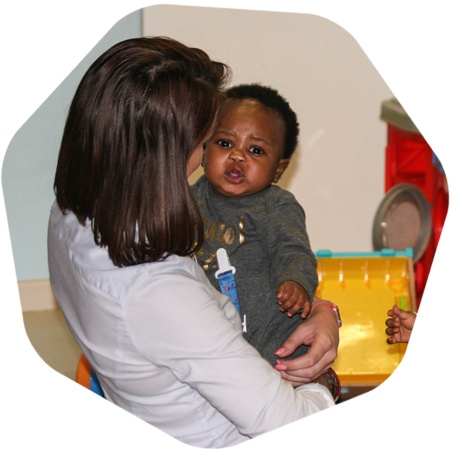
Blue Group: Turning One
Babies can start in blue group as early as 3-months and our nurturing carers will support them in their journey from wriggling to walking – helping them to expand their little worlds!
Enrol my child now
Blue Group Daily Routine:

Development and Learning Objectives for Blue Group Babies:
Language, Literacy and Creative Expression
Maths and Scientific Reasoning
Physical, Social and Emotional well-being
 Language, Literacy and Creative Expression
Language, Literacy and Creative Expression
Engages in music, art and dramatic play
1a. Shows interest in music, singing and dramatic play
1b. Begins to explore art materials
Receptive & Expressive vocabulary development
2a. Gurgles and coos
2b. Looks towards person speaking to them, uses pointing and other gestures to convey meaning
2c. Babbles word-like sounds
2d. Uses simple words “mama”, “hi”, ” bye-bye”
2e. Recognises own name
Coherent expression of personal ideas, thoughts, feelings
3a. Claps in excitement, shakes head to communicate “no” or refusal
3b. Nods heads “yes”, blows kisses and gives high fives
3c. Uses gestures, sounds, words and other actions to convey comprehension (when spoken to) and meaning (when responding)
Response to text
4a. Engages with books, points to pictures and turns pages.
Phonological Awareness
5a. Responds to familiar focal / repeat words or sounds, e.g. “peek-a-boo” = puts hands over eyes, “baa-baa” = points to ball)
 Maths and Scientific Reasoning
Maths and Scientific Reasoning
Verbal and object counting
10a. Imitates teacher counting 1, 2, 3 on fingers.
Relative Magnitude and Measurement
12a. Understands the difference between big/large and small/little.
Shape recognition and manipulation
13a. Matches shapes into slots (e.g. using shape bucket or shape peg puzzle)
Hypothesis formation
17a. Explores with intention: observes, touches, and reacts to objects and happenings around him/her
 pHysical and social emotional wellbeing
pHysical and social emotional wellbeing
Self regulation
18a. Cries or fusses to express immediate needs.
18b. Says “no” or shakes head when doesn’t want something
18c. Plays alongside peers (parallel play)
Response to expectations
19a. Adapts to / functions within the parameters of the classroom’s daily routine.
19b. Listens to and follows reasonable, basic direct requests from teacher
Positive sense of self
20a. Able to transition calmly between trusted caregivers (does not exhibit excessive seperation anxiety after a reasonable period).
19b. Listens to and follows reasonable, basic direct requests from teacher
Persistence in the face of challenges
21a. Displays willingness to attempt new tasks with support/prompting (doesn’t always return to the same toy/game)
Gross motor coordination
22a. Neck control is established
22b. Able to roll from lying on back to side and back
22c. Starts weight bearing on arms and kicks legs while on their tummy
22d. Able to sit with back support
22e. Starts to use both legs and arms to propel forward
22f. Start to pull themselves up against furniture, stands
22g. Able to sit safely in an appropriately-sized chair without tipping over / sliding off.
22h. Able to take a few steps with support from an adult or by cruising along holding onto the edge of something.
22i. Able to take steps independently, but with imperfect co-ordination
22j. Able to walk more than 10m with confidence.
22k. Able to move a motionless ball forward by nudging it with their foot or pushing it with their hand.
Fine motor coordination
23a. Squeezes sponge or hand or other soft object when touched to palm (palmer reflex).
22b.Uses index finger to point at objects and toys
23c. Pincer grip evident (picks up finger to thumb).
23d. Claps hands.
23e. Plays with toys at midline, and transfers from hand to hand
23f. Effectively manipulates sand and play dough.
23g. Slides a ring onto a tube.
23h. Crosses the midline by touching each hand to the opposing knee.
23i. Stacks blocks or other items to form 2-3 levels structures.